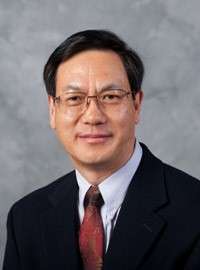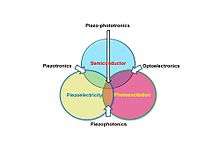Zhong Lin Wang
| Zhong Lin Wang | |
|---|---|
 | |
| Native name | 王中林 |
| Born | Shaanxi, China |
| Nationality | United States |
| Fields |
Physics Materials Science and Engineering |
| Institutions |
Georgia Institute of Technology Beijing Institute of Nanoenergy and Nanosystems |
| Alma mater |
Arizona State University Xidian University |
|
Website http://www.nanoscience.gatech.edu/ | |
Zhong Lin (ZL) Wang is a physicist, materials scientist and engineer specialized in nanotechnology and energy science. He received his PhD from Arizona State University in 1987. He is the Hightower Chair in Materials Science and Engineering and Regents' Professor at the Georgia Institute of Technology, USA.[1]
Education
- Ph.D. in Physics, Arizona State University, 1987.
- B.S. in Applied Physics, Xidian University, Xian, China, 1982.
Career
Wang was employed a visiting Lecturer at Stony Brook University from 1987 to 1988. After working as a research fellow in the following year at Cavendish Laboratory in the University of Cambridge, Wang joined Oak Ridge National Laboratory and the National Institute of Standards and Technology as a research scientist from 1990-1994. He was hired by Georgia Institute of Technology as an associate professor in 1995; he was promoted to full Professor in 1999, Regents’ professor in 2004, and the Hightower Chair in Materials Science and Engineering in 2010. Wang was the Director of the Georgia Tech’s Center for Nanostructure Characterization from 2000-2015. He is the founding director and director of the Beijing Institute of Nanoenergy and Nanosystems, Chinese Academy of Sciences since 2012.[2]
Research accomplishments

Wang has made original and seminal contributions to the synthesis, discovery, characterization, and fundamental understanding of the physical properties of zinc oxide nanobelts and nanowires.[3] He was the first to recognize and exploit the potential of ZnO nanostructures for innovative applications in energy, sensors, electronics, and optoelectronic devices. His discoveries and breakthrough works in developing nanogenerators have established the principle and technological road map for harvesting mechanical energy from the environment and biological systems for powering mobile sensors.[4] His research on triboelectric nanogenerators[5] and self-powered nanosystems[6] has inspired worldwide efforts in academia and industry for harvesting ambient energy for micro-nano-systems, which is now a distinct discipline in energy science for future sensor networks and internet of things.
Wang coined and pioneered the fields of piezotronics and piezo-phototronics by introducing piezoelectric potential gated charge transport process in fabricating strain-gated transistors for new electronics, optoelectronics, sensors, and energy sciences.[7] The piezotronic effect and piezo-phototronic effect first discovered by Wang have important impact to electronics and photonics of the third generation semiconductors.[8][9] The piezotronic transistors have applications in smart MEMS/NEMS, nanorobotics, human-electronics interface and sensors.
Wang’s pioneer work on in-situ measurements of mechanical and electrical properties of a single nanotube/nanowire inside a transmission electron microscope (TEM) opens a new field for TEM, which was what led to his seminal work on oxide nanostructures[10] and the inventions of various “nanogenerator” devices. His early work on inelastic scattering in electron diffraction and imaging establishes the theory of high-angle annular dark field imaging (HAADF) (so called Z contrast) in scanning transmission electron microscopy (STEM).[11]

Awards and Honors
Wang has received numerous honors award. They include: Thomson-Reuters Citation Laureate in Physics (2015);[12] Distinguished Professor Award (Highest faculty honor at Georgia Tech) (2014); NANOSMAT prize (United Kingdom) (2014); China International Science and Technology Collaboration Award (2014); The James C. McGroddy Prize for New Materials from American Physical Society (2014); ACS Nano Lectureship (2013); Edward Orton Memorial Lecture Award, American Ceramic Society (2012); MRS Medal from Materials Research Society (2011); Purdy award, American Ceramic Society (2009); John M. Cowley Distinguished Lecture, Arizona State University (2012); NanoTech Briefs, Top50 award (2005); Sigma Xi sustain research awards, Georgia Tech (2005); Georgia Tech faculty outstanding research author award (2004); S.T. Li Prize for Distinguished Achievement in Science and Technology (2001); Outstanding Research Author Award, Georgia Tech (2000); Burton Medal, Microscopy Society of America (1999).
Wang was elected as a foreign member of the Chinese Academy of Sciences in 2009, member of European Academy of Sciences in 2002, fellow of American Physical Society in 2005, fellow of AAAS in 2006, fellow of Materials Research Society in 2008, fellow of Microscopy Society of America in 2010, fellow of the World Innovation Foundation in 2002, and fellow of Royal Society of Chemistry. Wang’s research has been broadly covered by various media such as CNN and Reuters.[13][14][15] Wang is the founding editor and chief editor of an international journal Nano Energy.[16] Citations of his research and h-index can be found at.[17][18] Wang is a member of the Advisory Board of the newly launched Veruscript Functional Nanomaterials.[19]
References
- ↑ "Wang | School of Materials Science and Engineering". www.mse.gatech.edu. Retrieved 2016-02-05.
- ↑ "中国科学院北京纳米能源与系统研究所". www.binn.cas.cn. Retrieved 2016-02-05.
- ↑ Pan, Zheng Wei; Dai, Zu Rong; Wang, Zhong Lin (2001-03-09). "Nanobelts of Semiconducting Oxides". Science. 291 (5510): 1947–1949. doi:10.1126/science.1058120. ISSN 0036-8075. PMID 11239151.
- ↑ Wang, Zhong Lin; Song, Jinhui (2006-04-14). "Piezoelectric Nanogenerators Based on Zinc Oxide Nanowire Arrays". Science. 312 (5771): 242–246. doi:10.1126/science.1124005. ISSN 0036-8075. PMID 16614215.
- ↑ Zhu, Guang; Chen, Jun; Zhang, Tiejun; Jing, Qingshen; Wang, Zhong Lin (2014-03-04). "Radial-arrayed rotary electrification for high performance triboelectric generator". Nature Communications. 5: 3426. doi:10.1038/ncomms4426.
- ↑ Wang, Zhong Lin (2011). Nanogenerators for Self-powered Devices and Systems. Georgia Institute of Technology. ISBN 978-1-4507-8016-2.
- ↑ Wang, Zhong Lin. Piezotronics and Piezo-Phototronics - Springer. doi:10.1007/978-3-642-34237-0.
- ↑ Wu, Wenzhuo; Wang, Lei; Li, Yilei; Zhang, Fan; Lin, Long; Niu, Simiao; Chenet, Daniel; Zhang, Xian; Hao, Yufeng. "Piezoelectricity of single-atomic-layer MoS2 for energy conversion and piezotronics". Nature. 514 (7523): 470–474. doi:10.1038/nature13792.
- ↑ Wu, Wenzhuo; Wen, Xiaonan; Wang, Zhong Lin (2013-05-24). "Taxel-Addressable Matrix of Vertical-Nanowire Piezotronic Transistors for Active and Adaptive Tactile Imaging". Science. 340 (6135): 952–957. doi:10.1126/science.1234855. ISSN 0036-8075. PMID 23618761.
- ↑ Wang, Z. L.; Kang, Z. C. Functional and Smart Materials - Springer. doi:10.1007/978-1-4615-5367-0.
- ↑ Wang, Zhong Lin. Elastic and Inelastic Scattering in Electron Diffraction and Imaging - Springer. doi:10.1007/978-1-4899-1579-5.
- ↑ "Thomson Reuters Forecasts Nobel Prize Winners | Thomson Reuters". thomsonreuters.com. Retrieved 2016-02-05.
- ↑ "Video News - CNN.com". CNN. Retrieved 2016-02-05.
- ↑ "Researchers tap power in motion as energy alternative". Yahoo News. Retrieved 2016-02-05.
- ↑ "Physics World reveals its top 10 breakthroughs for 2012 - physicsworld.com". physicsworld.com. Retrieved 2016-02-05.
- ↑ "Nano Energy". Elsevier. Retrieved 2016-02-05.
- ↑ "Zhong Lin Wang E-2176-2011 - ResearcherID.com". www.researcherid.com. Retrieved 2016-02-05.
- ↑ "Zhong Lin (Z.L.) Wang 王中林 - Google Scholar Citations". scholar.google.com. Retrieved 2016-02-05.
- ↑ ""Veruscript Functional Nanomaterials"". Veruscript Functional Nanomaterials. 2016-11-23.